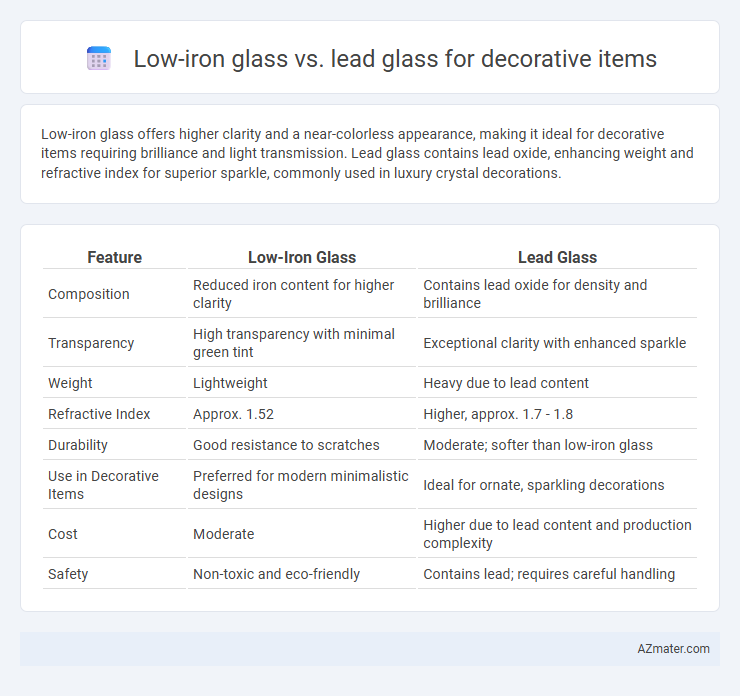Low-iron glass offers higher clarity and a near-colorless appearance, making it ideal for decorative items requiring brilliance and light transmission. Lead glass contains lead oxide, enhancing weight and refractive index for superior sparkle, commonly used in luxury crystal decorations.
Table of Comparison
| Feature | Low-Iron Glass | Lead Glass |
|---|---|---|
| Composition | Reduced iron content for higher clarity | Contains lead oxide for density and brilliance |
| Transparency | High transparency with minimal green tint | Exceptional clarity with enhanced sparkle |
| Weight | Lightweight | Heavy due to lead content |
| Refractive Index | Approx. 1.52 | Higher, approx. 1.7 - 1.8 |
| Durability | Good resistance to scratches | Moderate; softer than low-iron glass |
| Use in Decorative Items | Preferred for modern minimalistic designs | Ideal for ornate, sparkling decorations |
| Cost | Moderate | Higher due to lead content and production complexity |
| Safety | Non-toxic and eco-friendly | Contains lead; requires careful handling |
Introduction to Glass Types: Low-Iron vs Lead Glass
Low-iron glass, known for its high clarity and minimal greenish tint, is ideal for decorative items requiring enhanced transparency and true color representation. Lead glass, characterized by its high refractive index and density, creates exceptional brilliance and sparkle, making it a preferred choice for ornamental pieces like crystal vases and chandeliers. Both glass types offer unique optical properties that influence the aesthetic appeal and visual impact of decorative objects.
Composition and Manufacturing Processes
Low-iron glass contains minimal iron oxide, enhancing clarity and color neutrality, while lead glass incorporates lead oxide, increasing density and brilliance. Manufacturing low-iron glass requires selecting raw materials with reduced iron content and applying refining processes to minimize impurities, whereas lead glass production involves melting silica with lead oxide at controlled temperatures to achieve its characteristic high refractive index. Both glass types demand precise control over melting and cooling rates to ensure optimal optical properties for decorative items.
Optical Clarity and Color Characteristics
Low-iron glass offers superior optical clarity with minimal green tint, making it ideal for decorative items requiring true color representation and enhanced light transmission. Lead glass, containing higher lead oxide content, provides brilliant refraction and a warm, yellowish hue that adds a distinctive sparkle but can alter color perception. Choosing between the two depends on whether the priority is pure, color-neutral transparency or enhanced brilliance with color warmth in decorative applications.
Strength and Durability Comparison
Low-iron glass offers higher clarity and is less prone to discoloration, but it generally lacks the enhanced strength and impact resistance found in lead glass. Lead glass, enriched with lead oxide, provides superior durability, increased density, and greater hardness, making it more resistant to chipping and breakage in decorative items. For applications requiring both aesthetic brilliance and long-lasting structural integrity, lead glass is often preferred due to its robust mechanical properties.
Safety Concerns and Health Implications
Low-iron glass offers enhanced clarity and is free from toxic materials, making it a safer choice for decorative items compared to lead glass, which contains hazardous lead that can leach and pose serious health risks such as lead poisoning. Lead glass must be handled carefully and avoided in products that come into direct contact with food or skin to minimize exposure to harmful heavy metals. Choosing low-iron glass reduces long-term health implications and environmental hazards associated with lead contamination.
Decorative Appeal and Aesthetic Versatility
Low-iron glass offers exceptional clarity and brilliance, enhancing decorative items with a pure, colorless appearance that highlights intricate designs and color contrasts. Lead glass, also known as crystal, provides superior weight and light refraction, creating dazzling sparkle and depth that elevates the visual impact of ornamental pieces. Both materials cater to aesthetic versatility, with low-iron glass favoring modern, minimalist styles and lead glass excelling in traditional, luxurious decor.
Cost Differences and Market Availability
Low-iron glass typically costs less than lead glass due to its simpler manufacturing process and lower raw material expenses, making it a budget-friendly option for decorative items. Lead glass, known for its clarity and heavy weight, commands a higher price and is often reserved for luxury decor pieces, resulting in limited market availability compared to low-iron glass. The widespread production and distribution of low-iron glass contribute to its greater accessibility in the decorative item market.
Environmental Impact and Sustainability
Low-iron glass offers a more environmentally friendly option compared to lead glass due to its non-toxic composition and recyclability, reducing hazardous waste and pollution. Lead glass, while prized for its clarity and weight, poses significant sustainability challenges because of lead's toxicity and the potential for environmental contamination during production and disposal. Choosing low-iron glass supports sustainable decorative item manufacturing by minimizing ecological harm and enhancing recyclability without compromising aesthetic quality.
Popular Applications in Decorative Items
Low-iron glass offers superior clarity and brilliance, making it a popular choice for high-end picture frames, display cases, and decorative shelving where color accuracy and transparency are critical. Lead glass, also known as crystal, is favored for intricate decorative items such as vases, chandeliers, and art glass due to its higher refractive index and ability to be finely cut and engraved. Both materials enhance aesthetic appeal in decorative applications but are selected based on specific requirements like clarity for low-iron glass or brilliance and weight for lead glass.
Choosing the Right Glass for Your Decorative Needs
Low-iron glass offers exceptional clarity and a pristine, colorless appearance, making it ideal for decorative items that require a modern, sleek look. Lead glass, known for its high refractive index and brilliance, creates a sparkling effect popular in traditional luxury decor such as chandeliers and fine glassware. When choosing the right glass, consider whether you prefer low-iron glass's crystal-clear transparency or lead glass's radiant sparkle to best complement your decorative style and lighting conditions.

Infographic: Low-iron glass vs Lead glass for Decorative item
 azmater.com
azmater.com